Before you have your hip replacement, you, like my mom, will be told a whole slew of things that you are not allowed to do, if it is either a posterior, or a lateral hip replacement, and not many things if it is an anterior hip replacement. It all gets rather overwhelming, but not if you are aware of what you should be doing to arrive at the best outcome. So, I am going to try to make it all a bit clearer for you.
If you have had a posterior, or a lateral hip replacement, you are not to bend down, or forwards when seated, or standing, for up to 6 to 12 weeks post surgery.
For an anterior hip replacement the precautions are different, and typically you are not advised to avoid bending or reaching forwards.
You will have a range of precautions to observe after your hip surgery, and as I have said, these precautions will, for posterior and lateral hip replacements, from those for anterior hip replacements.
Patients with anterior hip replacements have far fewer precautions to follow, for reasons we will come to, than patients with the posterior and lateral hip replacements.
Typically, at 6 weeks post surgery, for all types of hip replacements, you will have an assessment with your surgeon, and he will tell you which precautions you still have to adhere to.
Depending on your age, general physical health, strength, your recovery progress, and how successful the surgeon was, the time when you can stop taking all the different precautions will differ.
CONTENTS - Overview & Quick Links
Can you bend at the waist after a hip replacement ?
How do you bend over after a hip replacement ?
What happens if you bend past 90 degrees after a hip replacement ?
Why can’t you bend over after a hip replacement ?
Positions to avoid after a posterior or lateral hip replacement
Positions to avoid after an anterior hip replacement
When can I sit in a normal chair after a hip replacement ?
How long after a hip replacement can I tie my shoes ?
Helpful items for after a hip replacement
Can you bend at the waist after a hip replacement ?
After a posterior or lateral hip replacement you will not be allowed to bend at the waist, when either sitting or standing, for up to 6 to 12 weeks.
This precaution is taken because it puts a great deal of stress on your new hip replacement when you adopt such a position.
After an anterior hip replacement you are allowed to bend at the waist, but do not force it if it is painful.
How do you bend over after a hip replacement ?
For Posterior and lateral Hip replacements
If you are sitting, or standing, and you wish to bend over, you can’t do this for up to 6 – 12 weeks, and your surgeon will tell you when you can.
You must not lean forward, or bend down to your feet when you are seated, or standing.
Your hip is already in flexion when you are seated, and will hopefully, if you are following the guidelines, be at around a 90-degree angle, or less. So, should you lean forwards, you will be bringing your upper body far too close to your knees, and putting way too much stress on your hip replacement.
If you are wondering how you will sit and dress yourself, there are quite a number of different dressing aids to help you to do this without bending forwards or leaning down, and I will be giving you a quick run through those a little further down the page.
If you need to pick something up when you are standing, it is again advised not to bend over for up to 6 to 12 weeks, and instead to use a reacher, or a grabber, to pick things up, until your surgeon has advised you otherwise.
For anterior hip replacements
There are no precautions for bending forward after an anterior hip replacement, so none of the above precautions apply.
What happens if you bend past 90 degrees after a hip replacement ?
Bending past 90 degrees after a posterior, or lateral hip replacement, puts you at risk of a dislocation of your new hip replacement.
If you dislocate the replacement, you will have to go to the emergency room, where the surgeon will have to put the joint back in place.
With an anterior hip replacement you do not have to worry about dislocating your hip replacement from bending forwards.
Why can’t you bend over after a hip replacement ?
The reason you cannot bend over after a posterior, or a lateral, hip replacement surgery, is that the muscles surrounding the hip, will be weakened with very little tone for some time, which can cause some instability in the joint, and it can lead to a minor risk of dislocations of the hip joint, for a number of weeks following the procedure.
Sitting down, standing up, and bending forwards in particular, can put more stress on the hip and lead to a dislocation.
To avoid this, one of the measures taken is to avoid bending over or reaching down for a period of time, while the muscles and the posterior capsule can heal and re-form.
Positions to avoid after a posterior, or a lateral hip replacement
Let’s take a look at this 90 degree rule that I keep referring to.
When lying down, standing, sitting, sitting down and standing up, after a “posterior” or “lateral” hip replacement, there are a number of precautions which need to be taken, with the angle of your hip replacement.
The 90 Degree Rule
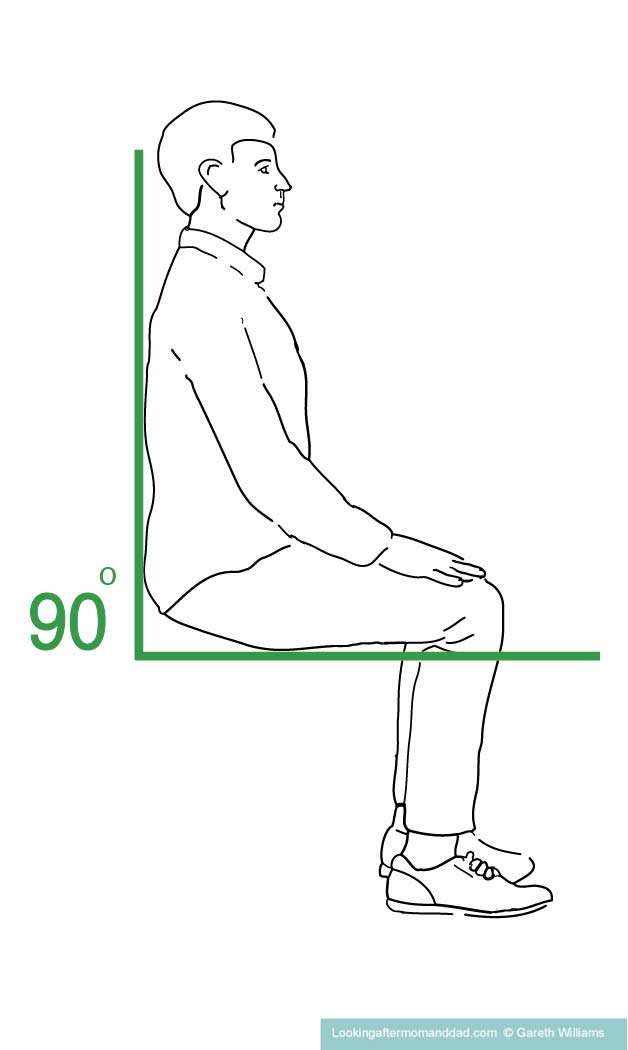
Illustration 1/
Illustration 1/, above, demonstrates the 90 degree rule for the sitting position.
This is the closest the knee, of the leg with the hip replacement, should come to your chest when you are sitting.
And your bottom should not be lower than your knees when you are seated – it can be higher than the knees, but never lower.
In the above seated position, you should –
- neither lean your torso forwards to the knees
- nor lift the knees upwards
Your hip should not be at a greater angle than 90 degrees during the first 6 to 12 weeks after you had your hip replacement – your surgeon will tell you when, everyone is different, and so is their recovery.
– if this angle business is a little confusing, imagine that when a person is standing their hip is at 0 degrees to the torso, so when the leg lifts upwards, the amount of degrees builds up, until you get to where the leg and hip are at a right angle to the body (90 degrees), this is the maximum you are supposed to bend your hip during the precaution period post surgery
By the way, the forward movement from the hip upwards is called flexion, and movement of the leg backwards at the hip is referred to as extension.
This is what is known as The 90 Degree Rule.
The period that you will be taking precautions will give the hip muscles and ligaments time for the healing, and while you’re having physical therapy, time to build those muscles back up.
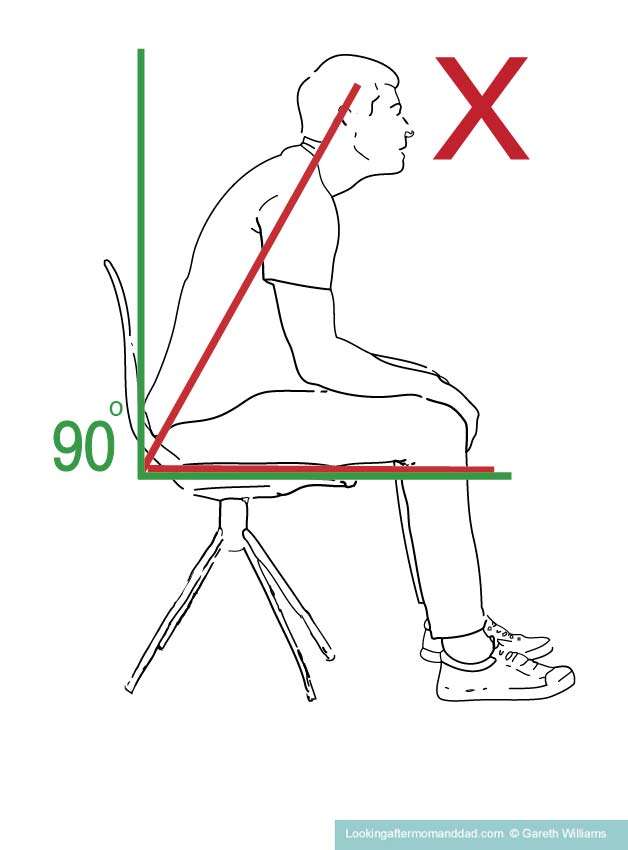
Illustration 2/
Illustration 2/, above, shows how you are not to lean forwards when seated, as this will exert pressure on the new hip replacement – try to remember that some of the biggest muscles in the buttocks have been cut, and the hip could move backwards if you do this before it has had time to heal.
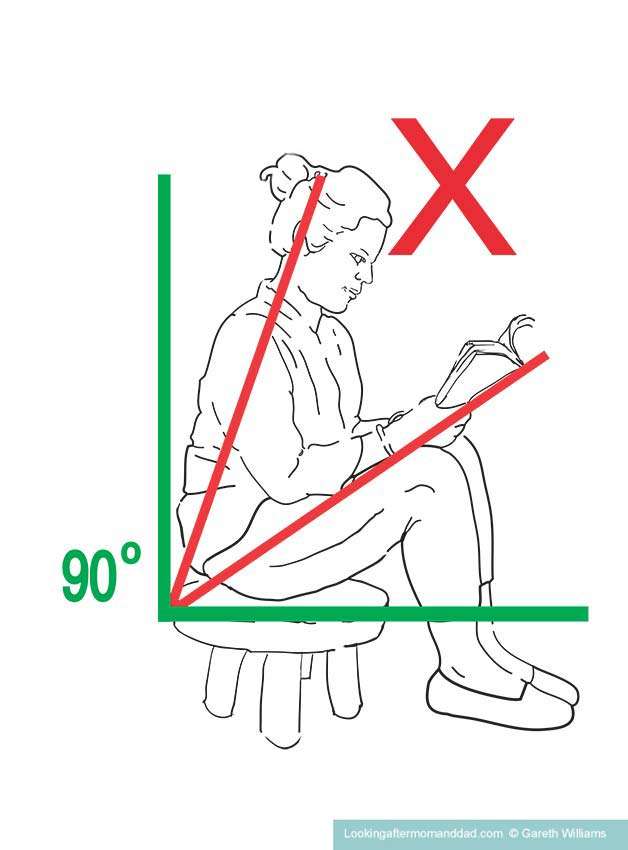
Illustration 3/
Illustration 3, above, is a really poor way of sitting after a posterior or lateral hip replacement, as the bottom is lower than the knees, and the character is leaning forwards.
This image is to demonstrate several important points –
1) firstly, there is the poor position of the knees on a low seat, in relation to the torso –
2) the bottom, is positioned at a lower level than the knees which is already exerting too much pressure on the hip, but it will also then cause a problem for standing up
3) as this character tries to stand up, they will not be able to do so, without leaning forwards to gain momentum to lift themselves upwards.
As they stand, this leaning forwards will even further reduce the distance between the knees/thighs and the torso, exerting a lot more pressure still, on the hip replacement, increasing the angle of the hip, and greatly increasing the chance of a dislocation of the hip.
This is why after a posterior or lateral hip replacement you are told not to sit on a seat which has your bottom closer to the floor than your knees.
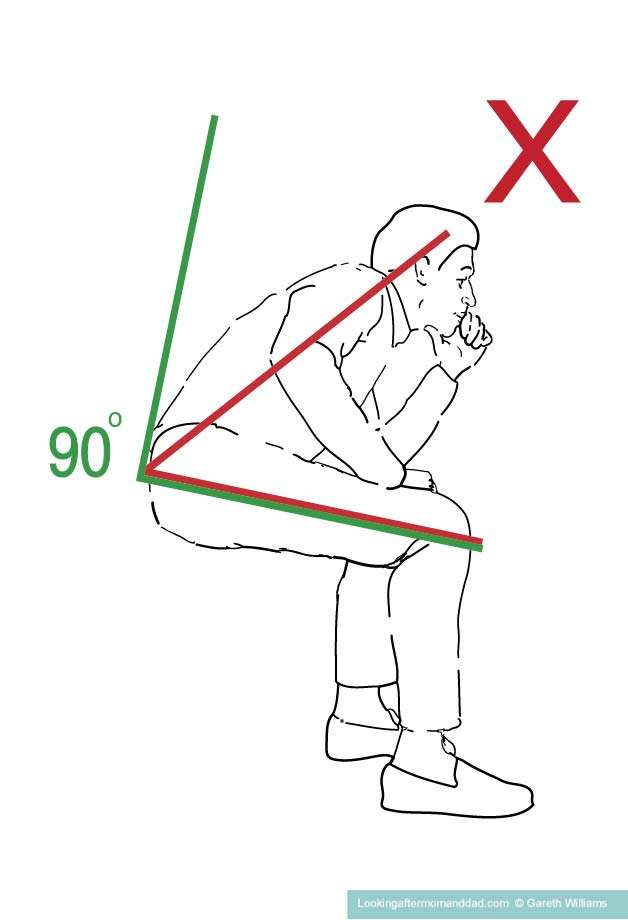
Illustration 4
The torso, in this situation, should be behind the 90 degree line if you are sitting upright, and ideally the vertical should be at about 110 degrees to the thighs and knees.
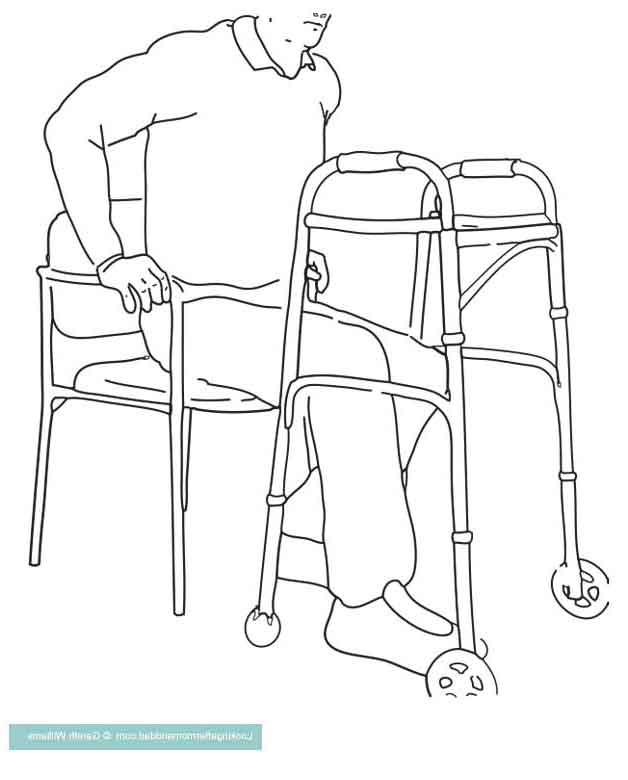
Illustration 5
Armrests
Armrests are recommended for the chairs you sit as they will help you to sit down and to stand up correctly, and to maintain good posture, as you do so without leaning forwards and breaking the 90 degree rule.
In Illustration 5/, above, you can see how the character is using the armrests of a chair to push up vertically to stand, stopping him from leaning forwards for momentum – his arms give him the thrust to rise.
Another little trick is to tuck your good leg slightly more under your body before you stand, and this will give you more power for standing up – your injured leg will be extended out in front, as you stand.
Without armrests, you have no choice but to lean forwards to build the momentum (even if you push up from the seat with one hand), again getting into a risky position, and exerting extra pressure on the new hip replacement.
If you want to know how to sit down, or stand up, after a posterior or lateral hip replacement, using a walker, I have an illustrated article “How To Sit On A Toilet After Hip Surgery: A Detailed Illustrated Guide”.
Again, I would like to point out that the article above is not for patients who have had an anterior hip replacement, as they will not have to follow any of these precautions.

Illlustration 6/
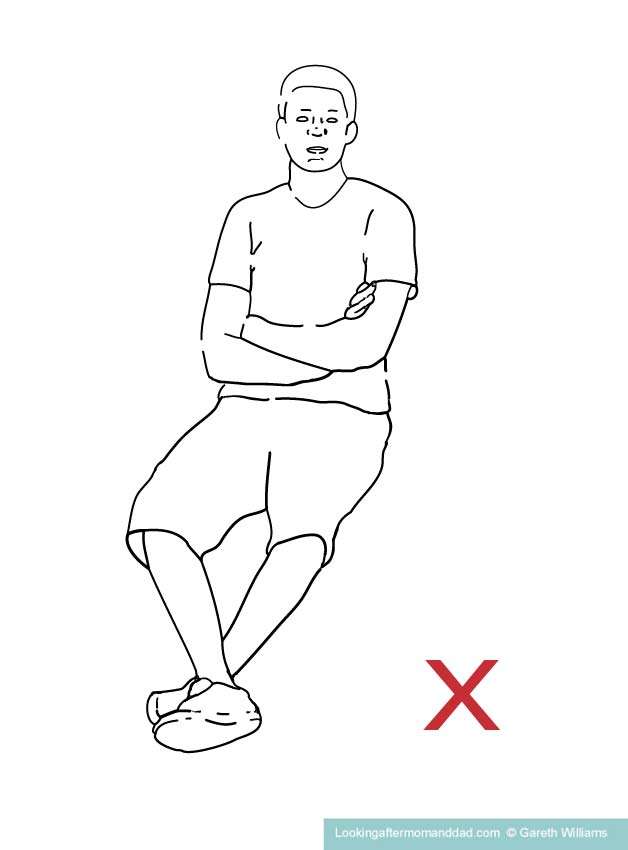
Illustration 7/
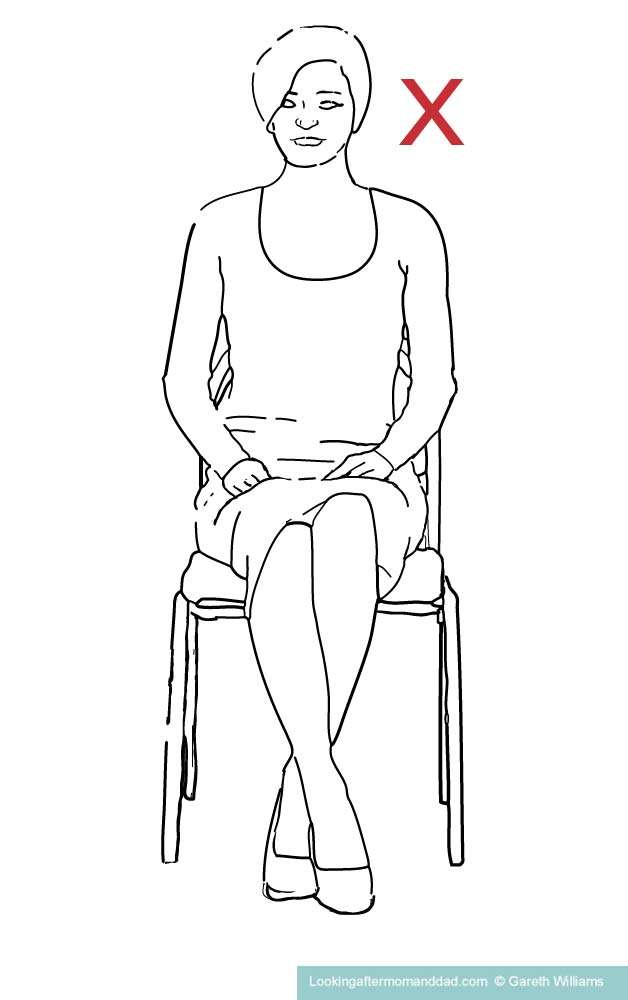
Illustration 8/
Don’t sit with your legs crossed after surgery
Illustrations 6-8 show a few more positions to avoid with your legs crossed.
While your muscles around the joint are still healing from the surgery, patients will be advised to keep their legs straight, not to cross them, and not to turn them inwards in any way.
This will typically be for the first 12 weeks.
Sleeping positions
There are a few precautions for sleeping –
- do not sleep on your stomach, as this will force your feet to point in or out, which twists your leg and hip, which can cause complications with the healing process
- the best position for sleeping is on your back
- if you are sleeping on your back, do not put pillows under your knees
- if you sleep on your back, have a pillow between your legs to stop you from twisting them, and don’t let your toes point inwards or outwards, but rather, straight up
- if you sleep on your side, you must not sleep on the hip replacement
- if you are sleeping on your side, you need to put a couple of pillows between your legs to keep your hip at a neutral angle
- if you are sleeping on your side, do not bend your knees beyond the 90 degree point for hip
- definitely don’t cross your legs when lying down or sleeping
- when you are lying down, do not reach forwards to pull up covers, use a reacher
Standing positions
There are only a few precautions for when you are standing and walking –
- do not bend down to pick things up – use a reacher
- stand with your toes pointing ahead of you or very slightly to the outside, but not inwards – this is to avoid twisting the hip
- do not pivot on your foot as it will twist your hip – if you wish to turn you do so with small steps
- do not twist your upper body when you are standing, always make small steps to turn where you wish to look
Positions to avoid after an anterior hip replacement
After an anterior hip replacement, you will be told to take a few precautions for up to 6 – 12 weeks, and your surgeon will let you know when you are okay.
During the surgery, something called the “anterior capsule” has to be cut through to be able to place the implants in. This contains soft tissue ligaments, and it will take 4 months for the capsule to “re-form”, so you will be told to avoid –
- although there is no 90 degree rule, some surgeons say not flex the hip beyond 120 degree for the first 6 weeks
- do not try to do sit-ups
- twisting the leg and foot to the outside – don’t point your toes to the outside and don’t allow the leg to rotate outwards
- do not pivot on your leg – turn in a series of smaller steps
- hip hyperextension – do not step backwards on your surgical leg – don’t extend your leg behind you, do not bend backwards (this means do not push your leg any further backwards than it goes when you are walking normally)
- do not push your hips forwards or bridge
- the best position to sleep is on your back, with a pillow between your legs to stop the hip from twisting
- do not put a pillow under your knees if you are sleeping on your back, as this will put pressure on your hips, and can lead to complications
- do not twist your knee outward in any sleeping position
- don’t cross your legs when lying down – put pillow when rolling onto your side
- if you don’t like to sleep on your back, sleep on the side without the surgery with pillows between your legs to align the hips
- do not lie, or sleep, on your stomach
- do not sleep in a recliner – the hip will become stiff and harder to straighten out
Activities which push the knee towards the head – this is hip flexion – are not a problem, as the “posterior capsule and muscles are intact”, and this is why you can reach forwards, and pick things up without any worry.
When can I sit in a normal chair after a hip replacement ?
I am not sure if you will want to sit down after reading all of this, unless you had an anterior hip replacement, as once again this does not apply to you, except to say don’t sit in really low chairs as they can cause you to strain yourself a little just after surgery !
If you had a posterior, or lateral hip replacement though, you cannot sit in a “normal” chair for up to 6 to 8 weeks, and to wait until your surgeon tells you it’s okay, which may be at your post operation assessment which should be 6 weeks after surgery.
It is also a good idea, even once you have the okay to sit in a normal chair, to use one with armrests until 3 months after your surgery, as this will help you to use your arms to push, and thus maintain the correct posture when standing, and so place less stress on the joint.
Until you are told it is okay, you need to sit in a chair with a straight back, with armrests, a solid seat, and a seat level which means that your hip is either level with your knees or slightly higher, but not below.
During the initial period post surgery, during which you are observing all the precautions, it is best to avoid rocking chairs, low stools, chairs on wheels, recliners, sofas and all chairs lower than the height of your knee from the floor, and without armrests.
How long after a hip replacement can I tie my shoes ?
Having read the first part of the article about bending or reaching down, you may have deduced that it will be awhile before you can tie your shoe laces the normal way, if you did not have an anterior hip replacement.
If you have had a posterior, or lateral hip replacement, you will have to wait up to 6 to 8 weeks, before you can tie your shoe laces the normal way, and again your surgeon will let you know when.
You do have two choices, and you can have tied shoe laces –
Elastic shoe laces – you can replace your normal shoe laces with elastic shoe laces before your surgery, and then tie them, and leave them so. You will then put your shoes on –
- using the reacher to place the shoe in position
- enter your toes into the shoe
- place the long-handled shoe horn behind your heel in the shoe
- slide your foot on into the shoe
The shoe laces will stretch enough to let you slide your foot into the shoe, and then will hold it on as normal.
You may want to run a few tests before you have your hip replacement to get used to the technique, and also to see how tightly you need to do the laces up.
Slip-on shoes – You will –
- position the shoe with the reacher
- hold the shoe in place with the reacher while you get your toes in the shoe
- take the log-handled shoe horn and place it behind your heel in the shoe
- slide your foot on into the shoe
And remember to stay sitting upright and not to bend forwards and break the 90 degree rule !!
If you have had an anterior hip replacement, you can put shoes on however you want to.
I hope all of these precautions are not depressing you too much, and I want now to introduce you to a bunch of assistive devices which are relatively inexpensive, and which will make all your “daily living activities” a whole lot simpler !
Helpful items for after a hip replacement
Your life can be made considerably easier after a hip replacement by some very inexpensive assistive aids, and three slightly more expensive ones – and again this mainly applies to individuals who have had a posterior, or a lateral hip replacement.
The devices are mostly to help you stop bending forwards, or reaching too far.
General –
– Reacher/ grabber – a basic lightweight, long handled, reaching aid which will allow you to pick up items without reaching down and bending.
– a leg lifter – this a type of strap with a semi-rigid section in the middle, is used to lift your leg when you are getting on an off a bed, or over the edge of the bathtub, if you are bathing using a bath transfer bench, or bath board.
It really is a fabulously simple device for getting your operated hip leg on, and off, the bed without too much pain, and it stops the user from bending their leg while doing so.
A little tip here – if you have someone helping you to get on and off the bed, you can also use a towel. Your carer can, once you are properly seated on the bed, put the towel around both your legs, and lift and slowly swing your legs up onto the bed, and of course taking care not to break the 90 degree rule. I was taught this by a nurse of many years experience, who was helping me, with my mom’s care right after her hip replacement.
Walking Aids –
– A walker – immediately after surgery you will be using walker with walking to help to maintain your balance, and to keep your weight off your new hip.
You will also need a walker for a number of weeks to help you with sitting down, and standing up, and especially when using the toilet.
– Canes or crutches – after the walker you will progress to walking with several crutches or canes, then one cane (in some cases hospitals prefer crutches, but eventually you will use a cane for a period of time).
Toileting Aids –
– A raised toilet seat – to elevate your toilet seat to the correct height.
– A bedside commode – this can be used as a raised toilet seat or as a toilet in a bedroom, which is especially handy for when you first come home from the hospital, and even more so at night.
– Toilet wands – allow you to clean yourself after going to the toilet to avoid bending or over reaching.
– Handheld bidets – these are a great way of cleaning yourself after going to the toilet – a lot easier than using a toilet wand.
Dressing Aids –
The following aids make dressing much more comfortable, without bending over or reaching down, and injuring your new hip.
– Elastic shoe laces – as I described above
– Slip on Shoes – (not a device, but they make life easier)
– Long handled shoe horn – this is a long shoe horn to facilitate putting your shoes, again as I described above
– Sock Aid – a device over which you slide your sock, place on the floor with a reacher, and into which you then put your foot – avoids you bending.
– Dressing stick – a long-handled stick with a hook on the end, designed to help you put your cloths on without twisting or bending in ways you should not.
Bathing aids
– Shower walker – if you wish to stand in the shower, and you are worried about slipping, you can get waterproof walkers specifically for this purpose.
– Bath transfer bench or Bath board – allows you to sit over your bathtub and wash.
– Shower chair or bench– makes showering safer.
– Long handled sponge – a long plastic handle with a sponge on the end to help you wash without bending or twisting.
– Hand-held shower head – this is very important – you won’t have to move around to get wet, or to rinse yourself, all with the aim of avoiding any twisting or bending.
– Non-slip rubber mat – wherever you are standing in water, you should have a non-slip mat – the shower for instance.
– Grab bars – on the walls of the shower and above the bathtub to provide support and avoid falls – I prefer the type which have a rough engraved grip, as your hands don’t slip when they are wet.
We have had three types of grab bars in our bathroom shower which are supposed to hold on to the wall by suction, and they all just fell off the wall by themselves, so I wouldn’t bother with buying those, I would only use the grab bars which you have to screw on to the wall – it isn’t that hard to do, I have put these up, and you can do it without breaking your tiles easily enough.
– Toilet safety frame – toilet safety frames can come without legs and attach to the toilet, and other models stand over the toilet on four legs. They are basically big armrests which help with sitting and standing up.
https://www.edwinsu.com/anterior-hip-replacement-post-op-instructions.html
https://www.newyorkhipknee.com/faqs/total-hip-replacement-faqs/
https://www.stefankreuzermd.com/anterior-hip-replacement.html
https://www.orthonewengland.com/wp-content/uploads/sites/156/2018/02/KENNON-DISCHARGE-INSTRUCTIONS-HIP-2016.pdf
https://www.nwh.org/classes-and-resources/patient-guides-and-forms/joint-replacement-surgery-patient-guide/joint-replacement-faqs
https://www.ozorthopaedics.com.au/blog/how-long-after-a-hip-replacement-can-i-tie-my-shoe-laces-23710.html
https://orthoinfo.aaos.org/en/recovery/activities-after-hip-replacement/
https://my.clevelandclinic.org/health/treatments/17102-hip-replacement
https://scottsdalejointcenter.com/patient-education/anterior-total-hip-replacement-precautions/
https://www.arthritis-health.com/surgery/hip-surgery/anterior-hip-replacement-dos-and-donts
https://ortho.duke.edu/sites/ortho.duke.edu/files/u18/Anterior%20Hip%20Precautions.pdf
https://www.sehat.com/sleeping-positions-after-anterior-hip-replacement
https://www.henrymayo.com/documents/CP-Anterior-Hip-Complete.pdf
I’m Gareth, the author and owner of Looking After Mom and Dad.com
I have been a caregiver for over 10 yrs and share all my tips here.

